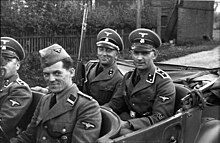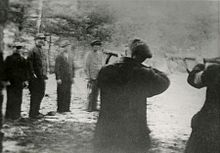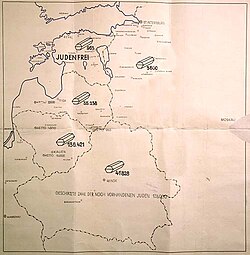Einsatzkommando
 German Einsatzkommando murder Polish civilians in Leszno, Poland on 21 October 1939 | |
| Formation | 1938 |
|---|---|
Membership | Approximately 3,000 |
Founder | Reinhard Heydrich |
During
Organization of the Einsatzgruppen
Einsatzgruppen (German: special-ops units) were paramilitary groups originally formed in 1938 under the direction of Reinhard Heydrich – Chief of the SD, and Sicherheitspolizei (Security Police; SiPo). They were operated by the Schutzstaffel (SS).[3] The first Einsatzgruppen of World War II were formed in the course of the 1939 invasion of Poland. Then following a Hitler-Himmler directive, the Einsatzgruppen were re-formed in anticipation of the 1941 invasion of the Soviet Union.[4] The Einsatzgruppen were once again under the control of Reinhard Heydrich as Chief of the Reich Security Main Office (RSHA); and after his assassination, under the control of his successor, Ernst Kaltenbrunner.[5][6]
Hitler ordered the SD and the Security Police to suppress the threat of native resistance behind the Wehrmacht's fighting front. Heydrich met with General
The military commanders knew the task of the Einsatzgruppen. The Einsatzgruppen depended upon their sponsoring army commander for billet, food, and transportation. Relations between the regular army and the SiPo and the SD were close. Einsatzgruppen commanders reported that the understanding by Wehrmacht commanders of Einsatzgruppen tasks made their operations considerably easier.
For Operation Barbarossa (June 1941), initially four Einsatzgruppen were created, each numbering 500–990 men to comprise a total force of 3,000.
The earliest Einsatzgruppen in occupied Poland
The first eight Einsatzgruppen of World War II were formed in 1939 for the
The SS operational groups were assigned Roman numerals for the first time on 4 September 1939. Before that, their names were derived from the names of their places of origin in the German language.[15]
- Einsatzgruppe I or EG I–Wien (under the command of SS-Standartenführer Bruno Streckenbach),[15] deployed with the 14th Army
- Einsatzkommando 1/I: SS-Sturmbannführer Ludwig Hahn
- Einsatzkommando 2/I: SS-Sturmbannführer Bruno Müller
- Einsatzkommando 3/I: SS-Sturmbannführer Alfred Hasselberg
- Einsatzkommando 4/I: SS-Sturmbannführer Karl Brunner
- Einsatzgruppe II or EG II–Oppeln (under SS-Obersturmbannführer Emanuel Schäfer),[15] deployed with the 10th Army
- Einsatzkommando 1/II: SS-Obersturmbannführer Otto Sens
- Einsatzkommando 2/II: SS-Sturmbannführer Karl-Heinz Rux
- Einsatzgruppe III or EG III–Breslau (under SS-Obersturmbannführer und Regierungsrat Hans Fischer),[15] deployed with the 8th Army
- Einsatzkommando 1/III: SS-Sturmbannführer Wilhelm Scharpwinkel
- Einsatzkommando 2/III: SS-Sturmbannführer Fritz Liphardt
- Einsatzgruppe IV or EG IV–Dramburg (under SS-Brigadeführer Pomorze(see also EG-V)
- Einsatzkommando 1/IV: SS-Sturmbannführer und Regierungsrat Helmut Bischoff
- Einsatzkommando 2/IV: SS-Sturmbannführer und Regierungsrat Walter Hammer
- Einsatzgruppe V or EG V–Allenstein (under SS-Standartenfürer Ernst Damzog),[15] deployed with the 3rd Army
- Einsatzkommando 1/V: SS-Sturmbannführer und Regierungsrat Heinz Gräfe
- Einsatzkommando 2/V: SS-Sturmbannführer und Regierungsrat Robert Schefe
- Einsatzkommando 3/V: SS-Sturmbannführer und Regierungsrat Walter Albath
- Einsatzgruppe VI (under SS-Oberführer Wielkopolskaarea
- Einsatzkommando 1/VI: SS-Sturmbannführer Franz Sommer
- Einsatzkommando 2/VI: SS-Sturmbannführer Gerhard Flesch
- Einsatzgruppe z. b. V.[16] (under SS-Obergruppenführer Udo von Woyrsch and SS-Oberfürer Otto Rasch), deployed in Upper Silesia and Cieszyn Silesia
- Einsatzkommando 16 or EK–16 Danzig (under SS-Sturmbannführer Rudolf Tröger),Piasnica Wielka (pictured). The civilian shooters belonged to Volksdeutscher Selbstschutz aiding EK–16. During that period approximately 12,000 to 16,000 Poles, Jews, Czechs, and Germans were murdered. Not to be confused with Einsatzkommando 16 of Einsatzgruppe E deployed in Croatia(see below)
Einsatzgruppe A
Einsatzgruppe A,
- Commanders
- SS-Brigadeführer und Generalmajor der Polizei Dr. Franz Walter Stahlecker (22 June 1941–23 March 1942)
- SS-Brigadeführer und Generalmajor der Polizei Heinz Jost (29 March–2 September 1942)
- SS-Oberführer und Oberst der Polizei Dr. Humbert Achamer-Pifrader (10 September 1942–4 September 1943)
- SS-Oberführer Friedrich Panzinger (5 September 1943–6 May 1944)
- SS-Oberführer und Oberst der Polizei Dr. Wilhelm Fuchs (6 May–10 October 1944)
- Sonderkommando 1a
- SS-Obersturmbannführer Dr. Martin Sandberger (June 1941–1943)
- SS-Obersturmbannführer Bernhard Baatz (1 August 1943–15 October 1944)
- Sonderkommando 1b
- SS-Oberführer und Oberst der Polizei Erich Ehrlinger (June–November 1941)
- SS-Sturmbannführer Walter Hoffmann (As Deputy) – (January–March 1942)
- SS-Obersturmbannführer Dr. Eduard Strauch (March–August 1942)
- SS-Sturmbannführer Dr. Erich Isselhorst (30 June–1 October 1943)
- Einsatzkommando 1a
- SS-Obersturmbannführer Dr. Martin Sandberger (June 1942–1942)
- SS-Obersturmbannführer Karl Tschierschky (1942)
- SS-Sturmbannführer Dr. Erich Isselhorst (November 1942 – June 1943)
- SS-Obersturmbannführer Bernhard Baatz (June–August 1943)
- Einsatzkommando 1b
- SS-Sturmbannführer Dr. Hermann Hubig (June–October 1942)
- SS-Sturmbannführer Dr. Manfred Pechau (October–November 1942)
- Einsatzkommando 1c
- SS-Sturmbannführer Kurt Graaf (1 August-28 November 1942)
- Einsatzkommando 2
- SS-Obersturmbannführer Rudolf Batz (June–4 November 1941)
- SS-Obersturmbannführer Dr. Eduard Strauch (4 November–2 December 1941)
- SS-Sturmbannführer Dr. Rudolf Lange (3 December 1941–1944)
- SS-Sturmbannführer Dr. Manfred Pechau (October 1942)
- SS-Sturmbannführer Reinhard Breder (26 March 1943 – July 1943)
- SS-Obersturmbannführer Oswald Poche (30 July 1943–2 March 1944)

- Einsatzkommando 3
- SS-Standartenführer Karl Jäger (June 1941–1 August 1943)
- SS-Oberführer und Oberst der Polizei Dr. Wilhelm Fuchs (15 September 1943–27 May 1944)
- SS-Sturmbannführer Hans-Joachim Böhme (11 May–July 1944)
Jäger Report
The Jäger Report is the most precise surviving chronicle of the activities of one Einsatzkommando. It is a tally sheet of the actions of Einsatzkommando 3—a running total of their killings of 136,421 Jews (46,403 men, 55,556 women, 34,464 children), 1,064 Communists, 653 persons with mental disabilities, and 134 others, from 2 July to 1 December 1941. A second, major sweep occurred in 1942, before
Einsatzgruppe B
The operational command of Einsatzgruppe B,
|
|
Scrambling to meet the "new threat", Gestapo headquarters in Zichenau (
In addition to mass shootings, Einsatzgruppe B engaged in public hangings used as a terror tactic on the local population. An Einsatzgruppe B report, dated 9 October 1941, described one such hanging. Due to suspected partisan activity in the area around the settlement of Demidov, all males aged fifteen to fifty-five in Demidov were detained in a camp for screening. The screening produced seventeen people identified as 'partisans' and 'communists'. Thereafter, 400 local residents were assembled to watch the hanging of five members of the group; the rest were shot.[22]
On 14 November 1941, Nebe told Berlin that, up until then, 45,000 persons had been eliminated. A further report, dated 15 December 1942, established that the Einsatzgruppe B had shot a total of 134,298 people.[23] After 1943, the mass killings of Einsatzgruppe B diminished, and the unit was decommissioned in August 1944.
- Commanders
- SS-Gruppenführer und Generalmajor der Polizei Arthur Nebe (June–November 1941)
- SS-Brigadeführer und Generalmajor der Polizei Erich Naumann (November 1941 – March 1943)
- SS-Standartenführer Horst Böhme (12 March–28 August 1943)
- SS-Oberführer und Oberst der Polizei Erich Ehrlinger (28 August 1943 – April 1944)
- SS-Oberführer und Oberst der Polizei Heinrich Seetzen (28 April–August 1944)
- SS-Standartenführer Horst Böhme (12 August 1944)
Around 5 July 1941, Nebe consolidated
On 5 August, Nebe moved his Einsatzgruppen command to
systematically attacking the local Jewish communities, and killing the inhabitants.Meanwhile, Einsatzkommando 9 was put to work; they had left Treuburg, in eastern Prussia, and reached Vilna on 2 July. Their main theater of mass killing operations were
.- Sonderkommando 7a
Sonderkommando 7a led by
. It executed 1344 people.- SS-Standartenführer Walter Blume (June–September 1941)
- SS-Standartenführer Eugen Steimle (September–December 1941)
- SS-Hauptsturmführer Kurt Matschke (December 1941 – February 1942)
- SS-Obersturmbannführer Albert Rapp (February 1942–28 January 1943)
- SS-Sturmbannführer Helmut Looss (June 1943 – June 1944)
- SS-Sturmbannführer Gerhard Bast (June–October/November 1944)
- Sonderkommando 7b
The Sonderkommando was active in
. It executed 6,788 people.- SS-Sturmbannführer Günther Rausch (June 1941 – January/February 1942)
- SS-Obersturmbannführer Adolf Ott (February 1942 – January 1943)
- SS-Obersturmbannführer Josef Auinger (July 1942 – January 1943)
- SS-Obersturmbannführer Karl-Georg Rabe (January/February 1943 – October 1944)
- Sonderkommando 7c
See also Vorkommando Moskau
- SS-Sturmbannführer Friedrich-Wilhelm Bock (June 1942)
- SS-Hauptsturmführer Ernst Schmücker (June 1942 – 1942)
- SS-Sturmbannführer Wilhelm Blühm (1942 – July 1943)
- SS-Sturmbannführer Hans Eckhardt (July–December 1943)
- Einsatzkommando 8
The Einsatzkommando was active in
. It executed 74,740 people.- SS-Obersturmbannführer Dr. Otto Bradfisch (June 1941–1 April 1942)
- SS-Sturmbannführer Heinz Richter (1 April–September 1942)
- SS-Sturmbannführer Dr. Erich Isselhorst (September–November 1942)
- SS-Obersturmbannführer Hans-Gerhard Schindhelm (7 November 1942 – October 1943)
- SS-Sturmbannführer Alfred Rendörffer (?)
- Einsatzkommando 9
The Einsatzkommando was active in
- SS-Obersturmbannführer Alfred Filbert (June–20 October 1941)
- SS-Obersturmbannführer Oswald Schäfer (October 1941 – February 1942)
- SS-Obersturmbannführer Wilhelm Wiebens (February 1942 – January 1943)
- SS-Obersturmbannführer Dr. Friedrich Buchardt (January 1943 – October 1944)
- SS-Sturmbannführer Werner Kämpf (October 1943 – March 1944)
- Vorkommando Moskau
The Vorkommando—also known as Sonderkommando 7c—was to operate in Moscow, until it became apparent that Moscow would not fall; it was incorporated to Sonderkommando 7b, where it was active in Smolensk and executed 4,660 people.
- SS-Brigadeführer Professor Dr. Franz Six (20 June–20 August 1941)
- SS-Obersturmbannführer Waldemar Klingelhöfer (August–September 1941)
- SS-Obersturmbannführer Dr. Erich Körting (September–December 1941)
- SS-Sturmbannführer Dr. Friedrich Buchardt (December 1941 – January 1942)
- SS-Sturmbannführer Friedrich-Wilhelm Bock (January–June 1942)
Einsatzgruppe C
The Einzatzgruppe C, as a whole, was attached to the Army Group South and executed 118,341 people.[17]
- SS-Brigadeführer und Generalmajor der Polizei Dr. Otto Rasch (June–October 1941)
- SS-Gruppenführer und Generalleutnant der Polizei Max Thomas (October 1941–29 April 1943)
- SS-Standartenführer Horst Böhme (6 September 1943 – March 1944)
- Sonderkommando 4a
The Sonderkommando was active in
. By 30 November 1941, the unit had executed 59,018 people.- SS-Standartenführer Paul Blobel (June 1941–13 January 1942)
- SS-Obersturmbannführer Erwin Weinmann (13 January–27 July 1942)
- SS-Sturmbannführer Eugen Steimle (August 1942–15 January 1943)
- SS-Sturmbannführer Friedrich Schmidt (January–February 1943)
- SS-Sturmbannführer Theodor Christensen (March–December 1943)
- Sonderkommando 4b
The Sonderkommando was active in
- SS-Obersturmbannführer Günther Herrmann (June–October 1941)
- SS-Obersturmbannführer Fritz Braune (2 October 1941–21 March 1942)
- SS-Obersturmbannführer Dr. Walter Hänsch (March–July 1942)
- SS-Obersturmbannführer August Meier (July–November 1942)
- SS-Sturmbannführer Friedrich Suhr (November 1942 – August 1943)
- SS-Sturmbannführer Waldemar Krause (August 1943 – January 1944)
- Einsatzkommando 5
The Einsatzkommando was active in
- SS-Oberführer Erwin Schulz (June–August 1941) [24]
- SS-Sturmbannführer August Meier (September 1941 – January 1942)
- Einsatzkommando 6
The Einsatzkommando was active in
- SS-Standartenführer Dr. Erhard Kröger (June–November 1941)
- SS-Sturmbannführer Robert Möhr (November 1941 – September 1942)
- SS-Obersturmbannführer Ernst Biberstein (September 1942 – May 1943)
- ?
- SS-Sturmbannführer Friedrich Suhr (August–November 1943)
Einsatzgruppe D
The Einsatzgruppe D, as a whole,

- Commanders
- SS-Gruppenführer und Generalleutnant der Polizei Dr. Otto Ohlendorf (June 1941 – July 1942)
- SS-Brigadeführer und Generalmajor der Polizei Walther Bierkamp (July 1942 – March 1943)
- Sonderkommando 10a
- SS-Oberführer und Oberst der Polizei Heinrich Seetzen (June 1941 – July 1942)
- SS-Sturmbannführer Dr. Kurt Christmann (August 1942 – July 1943)
- Sonderkommando 10b
- SS-Obersturmbannführer Alois Persterer (June 1941 – December 1942)
- SS-Sturmbannführer Eduard Jedamzik (December 1942 – February 1943)
- Sonderkommando 11a
- SS-Obersturmbannführer Paul Zapp (June 1941 – July 1942)
- Fritz Mauer (July–October 1942)
- SS-Sturmbannführer Dr. Gerhard Bast (November–December 1942)
- SS-Sturmbannführer Werner Hersmann (December 1942 – May 1943)
- Einsatzkommando 11b
- SS-Sturmbannführer Hans Unglaube (June–July 1941)
- SS-Obersturmbannführer Bruno Müller(July–October 1941)
- SS-Obersturmbannführer Werner Braune (October 1941 – September 1942)
- SS-Obersturmbannführer Paul Schultz (September 1942 – February 1943)
- Einsatzkommando 12
- SS-Obersturmbannführer Gustav Adolf Nosske (June 1941 – February 1942)
- SS-Sturmbannführer Dr. Erich Müller (February–October 1942)
- SS-Obersturmbannführer Günther Herrmann (October 1942 – March 1943)
Einsatzgruppe E
The Einsatzgruppe E was deployed in Croatia (i.e. in Yugoslavia) behind the 12th Army (Wehrmacht) in the area of Vinkovci (then Esseg), Sarajevo, Banja Luka, Knin, and Zagreb.
- Commanders
- SS-Obersturmbannführer Ludwig Teichmann (August 1941 – April 1943)
- SS-Standartenführer Günther Herrmann (April 1943–1944)
- SS-Oberführer und Oberst der Polizei Wilhelm Fuchs (October–November 1944)[26]
- Einsatzkommando 10b
- SS-Obersturmbannführer und Oberregierungsrat Joachim Deumling (March 1943 – January 1945)
- SS-Sturmbannführer Franz Sprinz (January–May 1945)
- Einsatzkommando 11a
- SS-Sturmbannführer und Regierungsrat Rudolf Korndörfer (May–September 1943)
- SS-Obersturmbannführer Anton Fest (September 1943–1945)
- Einsatzkommando 15
- SS-Hauptsturmführer Willi Wolter (June 1943 – September 1944)
- Einsatzkommando 16
- SS-Obersturmbannführer und Oberregierungsrat Johannes Thümmler (July–September 1943)
- SS-Obersturmbannführer Joachim Freitag (September 1943 – October 1944)
- Einsatzkommando Agram
- SS-Sturmbannführer und Regierungsrat Rudolf Korndörfer (September 1943)
Einsatzgruppe Serbien
- SS-Oberführer und Oberst der Polizei Wilhelm Fuchs (April 1941 – January 1942), Yugoslavia
- SS-Oberführer Emanuel Schäfer (January 1942)
Einsatzkommando Tunis
- Einsatzkommando headed by SS officer Walter Rauff in Tunis, North Africa.
Einsatzkommando Finnland
Officially the Einsatzkommando der Sicherheitspolizei und des SD beim AOK Norwegen, Befehlsstelle Finnland,
Einsatzkommando Italien
Planned Einsatzkommando units
- Einsatzkommando-6 – planned for the United Kingdom and headed by Dr. Franz Six (Aborted. Six reassigned to special unit to be activated following the capture of Moscow).
- Einsatzkommando Ägypten – planned for Jewish residents in the Middle East, including Palestine.
Notes
- ^ Thomas Urban, reporter of the Süddeutsche Zeitung; Polish text in Rzeczpospolita, Sept 1–2, 2001
- ^ JSTOR j.ctv1rmk6w.
- ^ Longerich 2012, pp. 405, 412.
- ^ Kershaw 2008, pp. 598, 618.
- ^ a b Longerich 2010, p. 185.
- ^ Longerich 2012, pp. 470, 661.
- ^ Browning 1998, pp. 10–12.
- ^ Langerbein 2003, pp. 31–32.
- Silesian Digital Library(Śląska Biblioteka Cyfrowa), Poland. Retrieved May 9, 2012.
- )
- )
- ^ Richard Rhodes, Masters of Death: The SS-Einsatzgruppen and the Invention of the Holocaust, Bellona 2008
- Jochen Bohler, Jürgen Matthäus, Klaus-Michael Mallmann, Einsatzgruppen in Polen, Wissenschaftl. Buchgesell 2008.
- International Institute for Holocaust Research. Washington, DC.
- ^ ISSN 1641-9561. Archived from the original(PDF file, direct download: 3.44 MB) on September 17, 2018. Retrieved March 25, 2015.
- ^ z. b. V. = zur besonderen Verwendung – "for special use".
- ^ )
- ISBN 978-1849546898.
- ISBN 978-0803222700. Retrieved 25 March 2015.
- ^ Tomasz Szarota (December 2–3, 2000). "Do we now know everything for certain? (translation)". Gazeta Wyborcza. Archived from the original on July 16, 2011. Retrieved May 13, 2011.
- ^ a b (in Polish) Thomas Urban, "Poszukiwany Hermann Schaper", Rzeczpospolita, 01.09.01 Nr 204
- ^ Headland 1992, pp. 57–58.
- Russian Army of Liberation." The relevant material is located on T-78/489/64750995144.
- ^ NS-Archiv : Dokumente zum Nationalsozialismus : Erwin Schulz, Eidesstattliche Erklärung Archived 2016-03-06 at the Wayback Machine (in German)
- ^ "Einsatzgruppe D. Organizational structure". The Holocaust Education and Archive Research Team. Archived from the original on March 4, 2016. Retrieved May 9, 2012.
- ^ "Einsatzgruppe E". TenhumbergReinhard.de. Retrieved 6 August 2016.
References
- Browning, Christopher R. (1998) [1992]. Ordinary Men: Reserve Police Battalion 101 and the Final Solution in Poland. Harper Perennial. ISBN 978-0060995065.
- Headland, Ronald (1992). Messages of Murder: A Study of the Reports of the Security Police and the Security Service. Associated University Presses. ISBN 0-8386-3418-4.
- ISBN 978-0-300-12427-9.
- Langerbein, Helmut (2003). Hitler's Death Squads: The Logic of Mass Murder. College Station, TX: Texas A&M University Press. ISBN 978-1-58544-285-0.
- ISBN 978-0-19-280436-5.
- Longerich, Peter (2012). Heinrich Himmler: A Life. Oxford; New York: Oxford University Press. ISBN 978-0-19-959232-6.
Further reading
- Trials of War Criminals Before the Nurenberg Military TribunalsUnder Control Council Law No. 10, Volume IV, Washington, D.C.: U.S. Government Printing Office. pp. 35–36
- MacLean, French (1999). The Field Men: The SS Officers Who Led the Einsatzkommandos – the Nazi Mobile Killing Units, Atglen, PA: Schiffer Publishing, ISBN 978-0764307546








